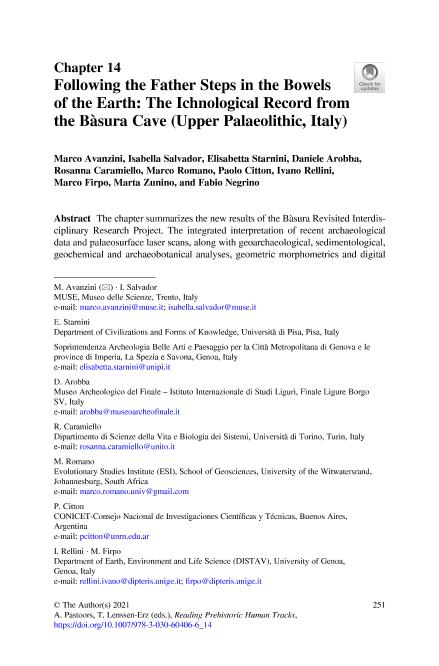Mostrar el registro sencillo del ítem
dc.contributor.author
Avanzini, Marco

dc.contributor.author
Salvador, Isabella

dc.contributor.author
Starnini, Elisabetta
dc.contributor.author
Arobba, Daniele
dc.contributor.author
Caramiello, Rosanna
dc.contributor.author
Romano, Marco

dc.contributor.author
Citton, Paolo

dc.contributor.author
Rellini, Ivano
dc.contributor.author
Firpo, Marco
dc.contributor.author
Zunino, Marta
dc.contributor.author
Negrino, Fabio
dc.contributor.other
Pastoors, Andreas
dc.contributor.other
Lenssen Erz, Tilman
dc.date.available
2023-07-03T18:25:10Z
dc.date.issued
2021
dc.identifier.citation
Avanzini, Marco; Salvador, Isabella; Starnini, Elisabetta; Arobba, Daniele; Caramiello, Rosanna; et al.; Following the father steps in the bowels of the Earth: The ichnological record from the Bàsura Cave (Upper Palaeolithic, Italy); Springer Nature Switzerland AG; 2021; 251-276
dc.identifier.isbn
978-3-030-60405-9
dc.identifier.uri
http://hdl.handle.net/11336/202099
dc.description.abstract
The chapter summarizes the new results of the Bàsura Revisited Interdisciplinary Research Project. The integrated interpretation of recent archaeological data and palaeosurface laser scans, along with geoarchaeological, sedimentological, geochemical and archaeobotanical analyses, geometric morphometrics and digital photogrammetry, enabled us to reconstruct some activities that an Upper Palaeolithic human group led inside a deep cave in northern Italy within a single exploration event about 14 ka calBP. A complex and diverse track records of humans and other animals shed light on individual- and group-level behaviour, social relationship and mode of exploration of the uneven terrain. Five individuals, composed of two adults, an adolescent and two children, entered the cave barefoot lightening the way with a bunch of wooden sticks (Pinus t. sylvestris/mugo bundles). While proceeding, humans were forced to move on all fours, and the traces they left represent the first report of crawling locomotion in the global human ichnological record. Anatomical details recognizable in the crawling traces show that no clothing was present between limbs and the trampled sediments. Our study demonstrates that very young children (the youngest about 3 years old) were active members of the human groups, even in apparently dangerous and social activities, shedding light on behavioural habits of Upper Palaeolithic populations.
dc.format
application/pdf
dc.language.iso
eng
dc.publisher
Springer Nature Switzerland AG

dc.rights
info:eu-repo/semantics/openAccess
dc.rights.uri
https://creativecommons.org/licenses/by/2.5/ar/
dc.subject
Upper Palaeolithic
dc.subject
Cave exploration
dc.subject
Animal and human footprints
dc.subject
Morphometric analysis
dc.subject
Human locomotion
dc.subject
Cave bear extinction
dc.subject.classification
Paleontología

dc.subject.classification
Ciencias de la Tierra y relacionadas con el Medio Ambiente

dc.subject.classification
CIENCIAS NATURALES Y EXACTAS

dc.subject.classification
Arqueología

dc.subject.classification
Historia y Arqueología

dc.subject.classification
HUMANIDADES

dc.title
Following the father steps in the bowels of the Earth: The ichnological record from the Bàsura Cave (Upper Palaeolithic, Italy)
dc.type
info:eu-repo/semantics/publishedVersion
dc.type
info:eu-repo/semantics/bookPart
dc.type
info:ar-repo/semantics/parte de libro
dc.date.updated
2022-09-20T10:52:42Z
dc.journal.pagination
251-276
dc.journal.pais
Alemania
dc.journal.ciudad
Berlín
dc.description.fil
Fil: Avanzini, Marco. Museo Delle Scienze Di Trento; Italia
dc.description.fil
Fil: Salvador, Isabella. Museo Delle Scienze Di Trento; Italia
dc.description.fil
Fil: Starnini, Elisabetta. Università degli Studi di Pisa; Italia
dc.description.fil
Fil: Arobba, Daniele. Museo Archeologico del Finale; Italia
dc.description.fil
Fil: Caramiello, Rosanna. Università di Torino; Italia
dc.description.fil
Fil: Romano, Marco. University of the Witwatersrand; Sudáfrica
dc.description.fil
Fil: Citton, Paolo. Consejo Nacional de Investigaciones Científicas y Técnicas. Centro Científico Tecnológico Conicet - Patagonia Norte. Instituto de Investigación en Paleobiología y Geología; Argentina
dc.description.fil
Fil: Rellini, Ivano. Università degli Studi di Genova; Italia
dc.description.fil
Fil: Firpo, Marco. Università degli Studi di Genova; Italia
dc.description.fil
Fil: Zunino, Marta. Grotte Di Toirano; Italia
dc.description.fil
Fil: Negrino, Fabio. Università degli Studi di Genova; Italia
dc.relation.alternativeid
info:eu-repo/semantics/altIdentifier/doi/https://doi.org/10.1007/978-3-030-60406-6_14
dc.relation.alternativeid
info:eu-repo/semantics/altIdentifier/url/https://link.springer.com/chapter/10.1007/978-3-030-60406-6_14
dc.conicet.paginas
436
dc.source.titulo
Reading Prehistoric Human Tracks: Methods and material
Archivos asociados
